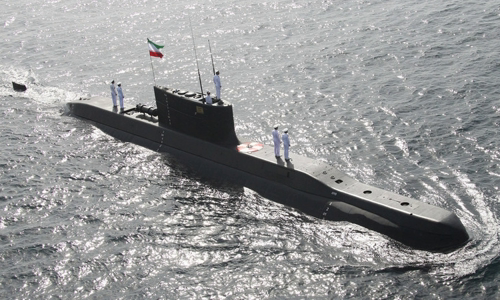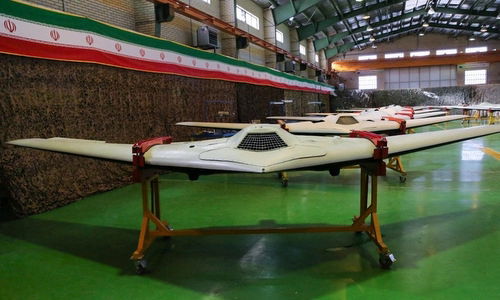Asymmetric weapons such as ballistic missiles and proxy forces help Iran bridge the gap in military power with powers like the United States.
After the US air strike killed General Qassem Soleimani, commander of the Quds task force of Iran's Islamic Revolutionary Guards (IRGC), Tehran faced many options to respond to Washington, from the small attacks of the party forces. duty, to a direct retaliation, which could spark large-scale war between the two countries.
Iran finally chose to launch multiple ballistic missiles against two bases with US troops stationed in Iraq at dawn on January 8. Military experts say this is Iran's most likely option, after years of focusing resources to build asymmetric combat capabilities, helping it deal with large and modern armies. many times.
The Iranian armed forces currently have 500,000 regular soldiers, including 125,000 IRGC soldiers. However, the large army is not an advantage in the confrontation with the world's leading military powers, especially when Iran does not own modern military equipment because of economic sanctions and restrictions. buying and selling weapons for many years.
To make up for this gap, Iran has pursued a solution to build asymmetric warfare capabilities, focusing on long-range offensive weapons that are difficult to intercept and a network of proxy militia throughout the Middle East, allowing them to causing serious damage to the enemy without having to bog down into traditional war.
"Iran will be crushed from a conventional military standpoint. Their permanent army is quite backward and does not have enough combat power. Tehran has invested all its resources in its asymmetric offensive capability. "They were very well prepared in this regard," a former British military official, who spoke on condition of anonymity, commented.
This strategy helps Iran avoid direct confrontation with the United States until tensions escalate over the air raid that killed General Soleimani.
Over the past decades, Tehran has invested heavily in building regional anti-access / denial (A2 / AD) capabilities to deter and prevent Washington's military operations in the Persian Gulf. At the core of this strategy are thousands of ballistic and cruise missiles built by Iran with support from Libya, North Korea and China.
The mainstay of the Iranian missile force is the Shahab series with three continuously upgraded variants. The most prominent version is the Shahab-3 medium-range ballistic missile developed from the North Korean Nodong-1 missile platform. Each ball has a range of 1,000-2,000 km depending on the version and can carry a nuclear warhead with a load of 1.2 tons. Shahab-3 allows Iran to threaten all US bases in the Middle East, Israeli territory and part of southwestern Europe.

Small-sized submarine of Iran after an exercise in February 2019 Photo: Fars News
Missile systems can cover the entire Middle East of Iran. Click on the image to see it in full.
Iran also has a long-range Soumar cruise missile developed from the Kh-55 for Soviet strategic bombers. Iran acquired some Kh-55 missiles in the early 2000s, then disassembled them to study and produce the Soumar variant using a conventional explosive device, mounted on the ground launcher and reaching a range of 2,500 km. .
Iranian cruise missiles and drones (UAVs) are believed to have been used in the raid on two Saudi oil refineries last September. The attack left Riyadh with 50% of its crude production, affecting 5% of global oil supply. The United States and Saudi Arabia accuse Iran of being behind the raid, but Tehran has denied any involvement.
The attack on the Aramco oil plant and the US base in Iraq showed that Iranian missiles were accurate enough to destroy infrastructure without causing casualties to nearby soldiers. "They use guided weapons. Iran does not want Americans to shed blood," said Tom Karako, director of the Rocket Defense Project at the US-based Center for Strategic and International Studies (CSIS). .
IRGC also invested in building a fleet of 2,000 high-speed boats with missiles and small submarines. They can appear anywhere in the Strait of Hormuz within minutes. Not only equipped with heavy machine guns, they can carry anti-ship missiles capable of sinking modern warships.
Even modern warships can hardly defend themselves against the siege of a large fleet of armed boats, especially if they receive support from mini submarines carrying anti-ship missiles and torpedoes. . Analysts believe that Iran has successfully developed a driverless speedboat named Ya Mahdi. They can be loaded with explosives and deployed in flashy attacks, difficult to detect via radar.
"Tehran does not need a large warship like the escorts and destroyers in the Persian Gulf. High speed boats, artillery and missile ships can lock the area down," Hossein Aryan, an analyst who served 18 year in the Iranian navy, remarks.

Stealthy UAV prototypes of Iran Photo: IBIS News
Iran also owns a variety of modern UAVs, making it a powerhouse for unmanned aircraft. "Iran is secretly promoting domestic UAV production and passing it on to allies to test its ability to fight with rivals in Iraq, Israel and Saudi Arabia," said Seth J. Frantzman, executive director of the Newspaper Center. Middle East Report and Analysis (MECRA) of the US, commented.
Iranian UAVs not only operate in the Persian Gulf or in the air of neighboring countries. They are gradually expanding their battlefields, potentially threatening the United States and its allies on various fronts. Hezbollah militia have deployed and improved UAVs to raid Israeli territory for years. Houthi rebels in Yemen also regularly use UAVs to attack Saudi infrastructure near the border.
"The Iranian military seems very weak when it comes to the number and type of ships, tanks, and fighters. However, they are a formidable opponent when it comes to anti-ship missiles, ballistic missiles and UAVs." , Jeremy Binnie, editor of the Middle East and Africa at military magazine Jane's Defense Weekly, said.
Delegated militias in Lebanon, Syria, Iraq, Yemen and the Gaza Strip have helped Iran significantly expand its influence in the region over the past 10 years. These are forces that can be deployed if the US-Iran military conflict breaks out, expanding the size of the battlefield to cause maximum damage to Washington.
At the core of this strategy is the Quds task force of the IRGC, which is dubbed the "extended arm that helps Iran strengthen its influence in the Middle East".
The Quds task force strictly applied the form of non-traditional and asymmetric warfare, because Tehran was unable to build a regular force to confront Washington directly. Their presence helps Iran maintain its deterrence to Israel and the United States, which have held hostilities with Tehran since the Islamic Revolution in 1979.
Rocket and mortar strikes against the US base in Iraq are the best evidence of Iranian-built proxies. "Iran will not be alone if it is attacked by the United States, because the fate of the Middle East region is closely tied to the Islamic Republic," Hassan Nasrallah, the leader of the Hezbollah armed group in Lebanon, said in February 2019.



 MistyReneFreudenberg
MistyReneFreudenberg







